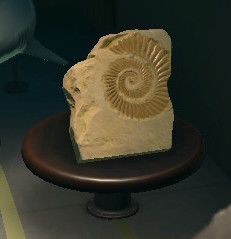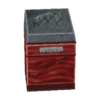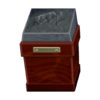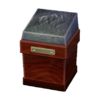Shark-tooth pattern
The shark-tooth pattern (known as the shark tooth prior to New Horizons) is a standalone fossil introduced in Animal Crossing: Wild World that appears in all subsequent games.
At the museum[edit]
In Wild World[edit]
When donating to Blathers in Wild World, he will provide the following information about the Shark-tooth pattern:
In City Folk[edit]
When donating to Blathers in City Folk, he will provide the following information about the Shark-tooth pattern:
In New Leaf[edit]
After donating the final part of the fossil in New Leaf, its plaque in the museum will read:
In New Horizons[edit]
When the player donates to Blathers or selects "Tell me about this!" in New Horizons, he will provide the following information about the fossil:
The Shark-tooth pattern can be found in the first room of the fossil exhibit in the museum.
As an item[edit]
In Wild World[edit]
| Shark tooth | |
|---|---|
| Sell price | |
| Colors | Gray
Brown
|
| HRA genre | Old-school |
| Size | |
In City Folk[edit]
| Shark tooth | |
|---|---|
| Sell price | |
| Colors | Gray
Brown
|
| HRA genre | Retro |
| Size | |
In New Leaf[edit]
| Shark tooth | |
|---|---|
| Sell price | |
| Colors | Gray
Brown
|
| Style | Historical |
| Size | |
In New Horizons[edit]
| Shark-tooth pattern | |
|---|---|
| Interactable | No |
| Sell price | |
| Colors | Beige
Brown
|
| Size | |
Real-world information[edit]
Helicoprion was a shark-like fish that lived off the southwestern coast of Gondwana in the Early to Middle Permian. While it is more closely related to sharks and other cartilaginous fishes than the bony fishes, its closest living relatives are actually the chimaeras, or rat fish. Like most cartilaginous fish, Helicoprion's body would have decayed quickly. As such, the only fossils found so far have been those of its tooth whorl. First described in 1899, the tooth whorl had baffled paleontologists for over a century, with ideas for what part of the body it was on ranging from the snout to the dorsal fin, to (possibly the most famous early idea) the outside of the lower jaw. Finally, in 2013, researchers working with related species discovered that the tooth whorl in fact sits inside the lower jaw. The whorl grows as Helicoprion ages, with newer teeth growing on the outside while the older teeth get pushed towards the middle of the spiral.
More information on this topic is available at Wikipedia.
Names in other languages[edit]
| サメのはのかせき |
||
| 상어 이빨 화석 Sang-eo Ippal Hwaseok |
||
| 鲨鱼牙齿化石 |
||
| 鯊魚牙齒化石 |
||
| Зубы ископаемой акулы |
||
| Haaientandkrans | Shark tooth wreath | |
| Haizahnspirale | Shark tooth spiral | |
| Mandíbula de tiburón | Shark jaw | |
| Mandibule d'hélicoprion | ||
| Mandibola di elicoprione | ||
| Fossils | ||||||||||||||||||||||||
|---|---|---|---|---|---|---|---|---|---|---|---|---|---|---|---|---|---|---|---|---|---|---|---|---|
| ||||||||||||||||||||||||







